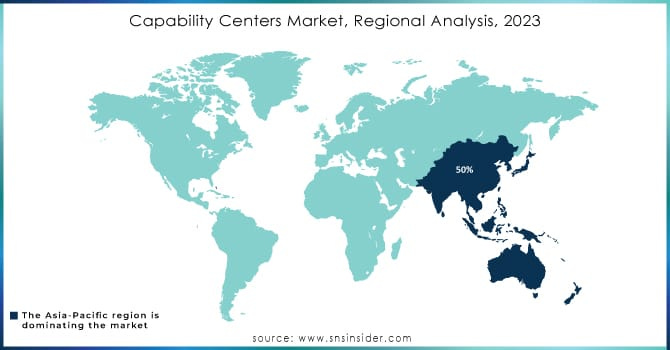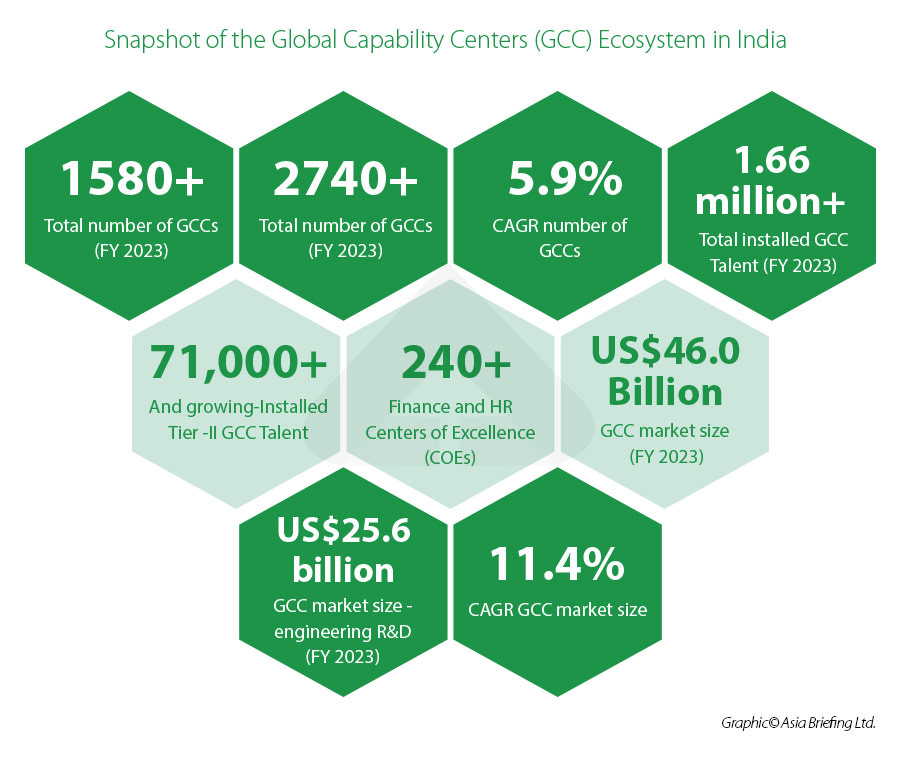Introduction: India’s GCC Boom
Heard of ICC, BCC but what’s GCC now?
Global Capability Centers (GCCs), also referred to as Global In-house Centers (GICs), are offshore facilities leveraged by multinational corporations (MNCs) to manage a variety of business functions and processes for their umbrella organizations. Earlier these supported back-office tasks in businesses, as well as end-to-end IT support services like maintenance and help centers. Business activities were initially limited to outsourced functions such as data processing, document management, and customer support. These GCCs have aided India in becoming a top location for MNCs from all over the world to set up Centers of Excellence (CoEs) across multiple areas, such as IT, business process management (BPM), research and development (R&D), finance, human resources (HR), healthcare, banking and financial services (BFSI) and other corporate roles.
Are you someone whose belief builds on numbers?
A PwC report suggests, with a market size of $46 billion, India’s GCC sector has achieved a CAGR of 11.4%. According to a report by Global Consultancy EY, it is sprinting towards a massive $110 billion by 2030. Over 1,500 GCCs have already made India their home, says a research study by ICICI Direct, with industries from healthcare to retail and tech. Some significant names are Google, Microsoft, JPMorgan Chase, and Siemens. Did you just go woah? Let’s keep the jaw dropped for some more time then. Come, let’s spill some tea.
Source: SNS insider
Why India? You could see that coming!
Let us try to understand by getting on the other side, by laying down an operational plan of setting up a GCC in India. Let’s look at how huge value for money and government support are a win-win for India’s GCC setup. We will break the analysis into two parts:
ROI Bonanza & Scaling Full Throttle
Companies pocket up to 30-50% on operational costs when put in comparison with markets in the West. Each year, the Indian workforce dissolves in 1.5 million STEM graduates, hence it won’t be an overstatement to say India moves forward with a huge trail of skilled professionals. AI, data analytics, finance, software development—whatever the world demands, India has it. Going big? Leveling up? Got you covered! While we come across the increasing population as a pain point in India’s growth, the simultaneously growing brigade of experts on demand is the silver lining. Mind you, when it's about brain power, India serves aces. We got your back with cost-effective, high quality and sustainable output (sasta, sundar, tikau).
Source: iSmartRecruit
Backing by the Statutes? Policy Perks to MNCs
The government’s PLI schemes offer lucrative incentives for GCC setup, which provides a strong kickstart for R&D and manufacturing. India is marching ahead with innovation fanatics like Phineas and Ferb at every nook. AI professionals saw 14X growth in the last seven years and Digital India initiatives changed the scenario—kind of like when Perry the Platypus goes from pet mode to secret agent mode. This blend of government backing with valuable human resources makes India the perfect hub for GCC growth.
There is absolutely no bureaucratic ‘We were on a break’ dilemma (unlike Ross) because contrary to some places, India’s policies aren’t ghosting businesses—they welcome them with wide arms and warm hearts! With streamlined regulations, tax exemptions, special economic zones (SEZs), and R&D grants, India has jumped 79 places in the World Bank’s Ease of Doing Business ranking since 2014, currently ranking 63rd globally. To further enhance the ease of doing business, the Government of India launched the National Single Window System (NSWS), a digital platform that integrates approvals from various Ministries, Departments, and State Governments. As of September 2023, the NSWS has onboarded approvals from 32 Central Ministries and Departments and 28 States and Union Territories, providing a one-stop clearance mechanism for investors and significantly reducing approval timelines. All these favorable bureaucratic conditions make India the upcoming GCC magnet.
Models of GCCs: The Flavors of Global Capacity Centers
Just like ‘Panipuris’ has different flavors, GCC also serves different models on the menu, each with its blend of control, flexibility, and efficiency.
Top-Down Model: The Corporate Command Center:
This is your classic ‘Big Boss Knows Best’ setup. Headquarters makes the decisions, and the GCC gets things done (well, that’s the plan anyway!). It’s efficient, no doubt. But innovation? Only if it can survive a marathon of approvals first!"
Self-Managed Model:
The Autonomous Ace : Think of this as the ‘start-up’ version of GCCs. the concentration of power is more with the center acting like the nucleus of a cell, sparking local innovation while still playing by global rules. If the arrow hits the target then all is well, otherwise the arrow may hit the company itself!
Digitally Optimized Function:
The AI-Infused Machine : This is the ‘Iron Man’ of GCCs—leveraging AI, automation, and advanced analytics to maximize efficiency. With smart workflows and predictive analytics, this model is the future. But remember, AI can’t (yet) replace human ingenuity—so let’s not hand over the reins just yet.
Remote Working Model:
It's the new trend in the corporate world, saving Bangalore's human resources from the never-ending traffic! It allows them to work from home with the comfort of their own bed. Then what's the catch? The work from Bali is not the ideal solution, right? Staying productive without drowning in Zoom calls and making sure ‘working from Bali’ isn’t just a vacation with a laptop!
Then, is Remote Working a Lubricant or Lignite for GCC’s Productivity?
Remote Work: Dream or Disaster?
On paper, remote work looks amazing—no commutes, comfy pajamas, and global hiring options. A Stanford study found that remote employees were 13% more productive. McKinsey reports that 87% of workers want flexible jobs—probably because they can do laundry between meetings.
But let’s be real—not everyone thrives remotely. A Harvard study found that employees who needed constant collaboration were 17% less productive at home. Security? A nightmare. IBM reports a 20% spike in cyber threats with remote setups. And don’t even get started on Zoom fatigue—nothing kills creativity like talking to frozen screens.
Office Life: Structure or Suffering?
The office has its perks—instant collaboration, strong mentorship, and free AC. A Microsoft study found that in-office employees were 25% more connected to their teams. That’s why Goldman Sachs and JP Morgan insist on full-time office work.
The old-school 9-to-5 grind? Yeah, that’s starting to feel like a relic of the past. According to Owl Labs, over a third (37%) of European workers would straight-up reject a job if it didn’t offer flexible hours. Even wilder? 69% would take a pay cut just to get that flexibility! (BusinessWire)
And let’s talk productivity—because guess what? 79% of people feel just as productive (if not more!) working remotely as sitting in an office. (BusinessWire)
Oh, and the fear is real—31% of employees are worried their company will drag them back to the office full-time with no hybrid option. (BusinessWire)
Bottom line? People aren’t just asking for flexibility anymore—they expect it. And if they don’t get it? They’re happy to walk away.
Hybrid: The Goldilocks of Work Models
Hybrid work is like Google Maps for work-life balance—it guides you somewhere in between. PwC says 71% of executives believe hybrid brings efficiency. Google provides 3 days in the office for teamwork, and 2 days remote for focus time. TCS allows only 25% of employees to be in the office at any given time. Microsoft, the king being king, let the teams themselves decide their own hybrid model.
Results: Hybrid The Hero
Remote work is awesome—until your Wi-Fi lags, data security turns into a horror movie, and company culture is just a bunch of Slack emojis. Office life keeps teams connected, but let’s be honest—rigid schedules and long commutes aren’t fun. Hybrid? That’s the sweet spot! GCCs that get the balance right will have the best of both worlds—teamwork without the micromanaging and flexibility without the madness
Friends and Foe: What’s Next for GCCs?
The GCC landscape isn’t all sunshine and rainbows. Here’s what’s keeping GCC leaders up at night:
Talent Retention & Upskilling: The Never-Ending Tug of War:
The war for talent is real, and GCCs need to keep employees engaged. Upskilling is crucial—because if your employees aren’t learning, they’re leaving (probably for a competitor offering free online courses!).
Data Security & ESG Compliance: The Legal Landmines:
With great power comes great responsibility—handling global data while meeting ever-changing compliance laws is no joke. Add ESG (Environmental, Social, and Governance) compliance to the mix, and GCCs are juggling more than ever before.
Global Uncertainties & Expansion: The Chess Game:
Economic downturns, geopolitical tensions, supply chain disruptions—oh my! Expanding in this unpredictable world requires a mix of agility, strategy, and, let’s be honest, a bit of luck.
Rise of AI & Automation-Driven GCCs: The Future is Now:
AI is shaking things up—automation is making processes faster, and GCCs are becoming hubs for AI-driven innovation. The challenge? Finding the sweet spot between automation and human expertise.
Case study: Success in Action
Now that we've wrapped our heads around GCC, let's see how Google put it to work. Not merely corporate outposts, but Google’s worldwide Capability Centers (GCCs) in India are high-octane innovation engines that secretly turn India into a worldwide digital powerhouse while advancing the company's technological domination. Cybersecurity, artificial intelligence, cloud computing, and fintech are all continuously being reinvented at Google's hidden laboratories, which are situated in Bengaluru and Hyderabad (with aspirations to expand into Tier II and III cities). The "Cash nahi hai, Google Pay kar doon?" dilemma will never arise again. These teams are coordinating AI-powered automation, optimizing search engines, and strengthening Google Cloud's widespread presence in addition to payments.
Unlike typical outsourcing, where innovation is an afterthought, Google's Indian GCCs are tightly integrated into the company's global decision-making matrix, influencing the very core of its technological progress. But Google isn't just looking to poach India's finest talent; it's creating it. Google has weaponized education by forming alliances with IITs and other prestigious institutions, producing AI and cloud specialists capable of programming their way out of a black hole. Meanwhile, sustainability and ESG activities are more than just words. It has also integrated energy-efficient data centers, ethical AI governance, and green tech solutions into its GCC framework. Let's not forget about cybersecurity, because in a world where data is the new oil, Google's Indian teams are the digital oil barons, who are staying ahead of ever-evolving global regulations.
Now let's talk about money. Google's overall operations in India have shown a significant impact, an example of which is mentioned in the report by Inc42 which highlighted that its advertising revenue rose by 12.5% year-on-year to ₹28,040 crore in FY23. These centers while providing high-paying jobs are also decentralizing India's tech industry and accelerating the growth of non-metro innovation clusters. Google is also employing engineers by expanding into Tier II and III cities and creating complete digital ecosystems. One might raise a question, what about the ripple effect? The Indian startup sector is prospering, with Google's resources and experience catalyzing AI-driven entrepreneurship and financial disruptors at dizzying speed.
Source: india-breifing.com
Conclusion
India's growth as a GCC powerhouse is not an accident but the result of a huge skill set, cost benefits, and strong government backing. It is visible how now, businesses chase for innovation and as much scalability as possible. India provides the ideal balance with top-down leadership and digitally optimized functions. The new paradigm of frictionless remote work has transformed the production landscape serving both as an opportunity and a challenge, yet retention of talent, secure data transmission, and the emergence of AI-based automation promise to wear away do remain formidable issues. The case of Google and SAP serves to illustrate how a properly conceived GCC can spell global success. For what is now clear, India is not just a preferred destination for GCCs, it is changing the geographics of business and innovation in the world.
References:
1. HSBC Business Go. (n.d.). https://www.businessgo.hsbc.com/en/article/what-are-global-capability-centres-gccs-in-india
2. ArindamSen. (n.d.). https://www.ey.com/en_in/people/arindam-sen
3. Ghodasara, A. (2025, February 26). 15 funny recruiting memes that’ll make recruiters go ROFL. iSmartRecruit. https://www.ismartrecruit.com/blog-funny-recruiting-memes-for-recruiters
4. Business Media Private Limited. (2023b, August 24). 14X growth in AI professionals in India in last 7 years: LinkedIn’. Business Media Private Limited. https://www.fortuneindia.com/enterprise/14x-growth-in-ai-professionals-in-india-in-last-7-years-linkedin/113844
5. EASE OF DOING BUSINESS | Make in India. (n.d.-b). https://www.makeinindia.com/eodb
6. Govt policies boosting foreign investments in India. (n.d.-b). https://pib.gov.in/Pressreleaseshare.aspx?PRID=2042114
7. Analytics India Magazine. (2025, January 13). Talent landscape for AI/ML engineers in India. https://analyticsindiamag.com/ai-trends/talent-landscape-for-ai-ml-
8. Banerjee, I., Chanakya, A., Das, A. C., & Lal, A. (2020, August 4). Global capability centers in the next normal. McKinsey & Company. https://www.mckinsey.com/capabilities/mckinsey-digital/our-insights/global-capability-centers-in-the-next-normal?
9. Sar, Y. (2024, August 16). Council Post: The Silent Burden of AI: Unveiling the hidden environmental costs of data centers by 2030. Forbes. https://www.forbes.com/councils/forbestechcouncil/2024/08/16/the-silent-burden-of-ai-unveiling-the-hidden-environmental-costs-of-data-centers-by-2030/
10. Post, L. G. (2024, September 29). India’s growing role in the Global Capability Center (GCC) ecosystem: opportunities and challenges. London Daily News. https://www.londondaily.news/indias-growing-role-in-the-global-capability-center-gcc-ecosystem-opportunities-and-challenges
11. Zinnov. (2025, January 8). Global Capability Centers in India: Karnataka’s rise as a GCC hub. Zinnov. https://zinnov.com/centers-of-excellence/global-capability-centers-in-india-karnatakas-rise-as-a-gcc-hub-report/
12. Singh, N. (2025, February 13). The Rise of Global Capability Centers (GCCs) in India’s IT Sector. Inductus’ Global Capability Centre ‘GCC’ in India. https://inductusgcc.com/the-rise-of-global-capability-centers-gccs-in-indias-it-sector/?utm_source=chatgpt.com
13. Direct, I. (2024, December 31). What are Global capability centres? ICICI Direct. https://www.icicidirect.com/research/equity/finace/what-are-global-capability-centres











